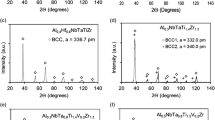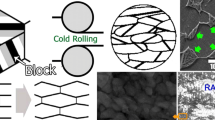Abstract
Neutron diffraction has been used to investigate the stress field in two different welds developed for nuclear applications, namely those obtained by tungsten inert gas welding of P91 martensitic steel (Cr 9, Mn 6, Mo 1, C 0.1, and Fe bal wt %) and hybrid (laser beam and gas metal arc) welding of AISI316LN austenitic steel (17.8 Cr, 12.3 Ni, 1.7 Mn, 2.4 Mo, 0.3 Si, and Fe bal wt %). The sizes of the investigated samples were 100 × 50 × 12 mm for the P91 weld and 220 × 160 × 15 mm for the 316LN weld; unstrained references were prepared for both welds. The neutron diffraction measurements have been carried out utilizing the E3 diffractometer at the BER II reactor in Berlin, with a gauge volume of 2 × 2 × 2 mm3. Lines perpendicular to the weld direction were scanned at different depths inside the material and at different distances from the weld centerline, including the heat affected zone and the weld centerline. Strain and stress values were determined in the three principal directions. In the TIG P91 weld, the stresses are almost completely relieved after a post weld heat treatment for 2 h at 760°C. In the laser beam and gas metal arc 316LN weld not submitted to post weld heat treatment, nearly balancing longitudinal and transverse stress components as high as 300–350 MPa are found within a range of approximately 3 mm around the centerline of weld.








Similar content being viewed by others
REFERENCES
B. Hayes, Eng. Failure Anal. 3, 157 (1996). https://doi.org/10.1016/1350-6307(96)00015-5
D. Smith, P. Bouchard, and D. George, J. Strain Anal. Eng. Des. 35, 287 (2000). https://doi.org/10.1243/0309324001514422
K. Kang and L. Kupca, Integrity of Reactor Pressure Vessel Steels in Nuclear Power Plants: Assessment of Irradiation Embrittlement in Reactor Pressure Vessel Steels, IAEA Nuclear Energy Series, NP-T-3.11 (IAEA, Vienna, 2009).
G. D. Bokuchava, P. Petrov, and I. V. Papushkin, J. Surf. Invest.: X-Ray, Synchrotron Neutron Tech. 10, 1143 (2016). https://doi.org/10.1134/S1027451016050463
C. Ohms, R.V. Martins, O. Uca, A. G. Youtsos, P. J. Bouchard, M. Smith, M. Keavey, S. K. Bate, P. Gilles, R. C. Wimpory, and L. Edwards, in Proceedings of ASME PVP 2008 (Chicago, USA, July 27–31,2008), No. I795CD.
M. C. Smith, A. C. Smith, R. C. Wimpory, and C. Ohms, Int. J. Pressure Vessels Piping 120–121, 93 (2014). https://doi.org/10.1016/j.ijpvp.2014.05.002
MATerials TEsting and Rules (MATTER) project. http://www.matterfp7.it/Layout/matter/index.asp
European Energy Research Alliance, Joint Programme on Nuclear Materials. http://www.eera-jpnm.eu/.
G. Barbieri, M. Cesaroni, L. Ciambella, G. Costanza, and R. Montanari, Metall. Ital. 107 (3), 37 (2015).
L. Forest et al., CEA Report DEN/DANS/DM2S/SEMT/LTA/NT/14-002/A (2014).
M. Hutchings, P. Withers, T. Holden, and T. Lorentzen, Introduction to the Characterization of Residual Stress by Neutron Diffraction (Taylor & Francis, Boca Raton, 2005).
M. Boin and R. C. Wimpory, J. Large-Scale Res. Facilities 2, A100 (2016). http://dx.doi.org/10.17815/jlsrf-2-126
ACKNOWLEDGMENTS
The Helmholtz Zentrum Berlin is gratefully acknowledged for beam-time allocation, technical assistance and travelling support. Dr. M. Valli (ENEA) is acknowledged for help in handling the P91 weld data.
Funding
The research has been carried out in the frame of EERA Joint Program on Nuclear Materials and is partly funded by the European Commission HORIZON 2020 Framework Program (grant agreement no. 755269).
Author information
Authors and Affiliations
Corresponding author
Rights and permissions
About this article
Cite this article
Agostini, P., Barbieri, G., Coppola, R. et al. Stress Distributions in P91 Martensitic Steel and in AISI 316LN Steel Welds for Gen IV Nuclear Applications. J. Surf. Investig. 14 (Suppl 1), S25–S30 (2020). https://doi.org/10.1134/S1027451020070022
Received:
Revised:
Accepted:
Published:
Issue Date:
DOI: https://doi.org/10.1134/S1027451020070022




